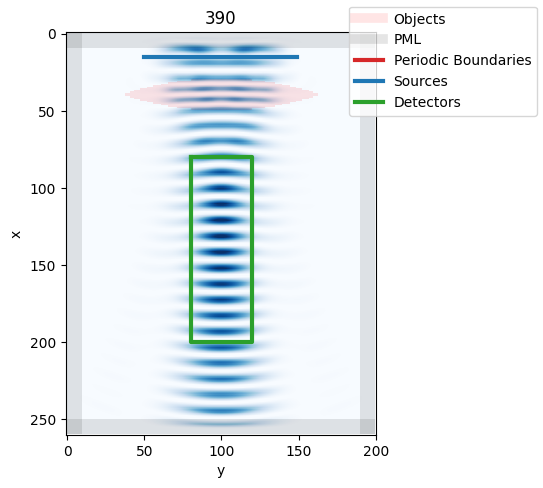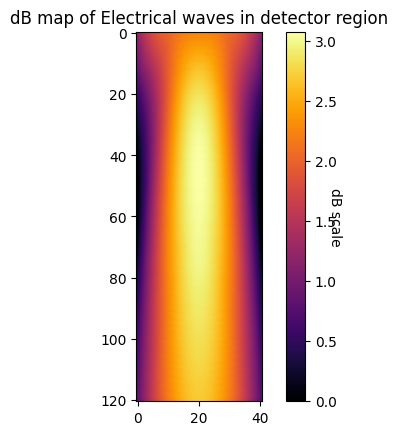05. Lenses and analysing lensing actions
submitted by substancia, adapted by flaport
Imports
[1]:
import os
import fdtd
import numpy as np
import matplotlib.pyplot as plt
Grid
[2]:
grid = fdtd.Grid(shape=(260, 15.5e-6, 1), grid_spacing=77.5e-9)
# x boundaries
grid[0:10, :, :] = fdtd.PML(name="pml_xlow")
grid[-10:, :, :] = fdtd.PML(name="pml_xhigh")
# y boundaries
grid[:, 0:10, :] = fdtd.PML(name="pml_ylow")
grid[:, -10:, :] = fdtd.PML(name="pml_yhigh")
simfolder = grid.save_simulation("Lenses") # initializing environment to save simulation data
print(simfolder)
/home/docs/checkouts/readthedocs.org/user_builds/fdtd/checkouts/latest/docs/examples/fdtd_output/fdtd_output_2023-5-23-13-14-41 (Lenses)
Objects
defining a biconvex lens
[3]:
x, y = np.arange(-200, 200, 1), np.arange(190, 200, 1)
X, Y = np.meshgrid(x, y)
lens_mask = X ** 2 + Y ** 2 <= 40000
for j, col in enumerate(lens_mask.T):
for i, val in enumerate(np.flip(col)):
if val:
grid[30 + i : 50 - i, j - 100 : j - 99, 0] = fdtd.Object(permittivity=1.5 ** 2, name=str(i) + "," + str(j))
break
Source
using a continuous source (not a pulse)
[4]:
grid[15, 50:150, 0] = fdtd.LineSource(period=1550e-9 / (3e8), name="source")
Detectors
using a BlockDetector
[5]:
grid[80:200, 80:120, 0] = fdtd.BlockDetector(name="detector")
Saving grid geometry for future reference
[6]:
with open(os.path.join(simfolder, "grid.txt"), "w") as f:
f.write(str(grid))
wavelength = 3e8/grid.source.frequency
wavelengthUnits = wavelength/grid.grid_spacing
GD = np.array([grid.x, grid.y, grid.z])
gridRange = [np.arange(x/grid.grid_spacing) for x in GD]
objectRange = np.array([[gridRange[0][x.x], gridRange[1][x.y], gridRange[2][x.z]] for x in grid.objects], dtype=object).T
f.write("\n\nGrid details (in wavelength scale):")
f.write("\n\tGrid dimensions: ")
f.write(str(GD/wavelength))
f.write("\n\tSource dimensions: ")
f.write(str(np.array([grid.source.x[-1] - grid.source.x[0] + 1, grid.source.y[-1] - grid.source.y[0] + 1, grid.source.z[-1] - grid.source.z[0] + 1])/wavelengthUnits))
f.write("\n\tObject dimensions: ")
f.write(str([(max(map(max, x)) - min(map(min, x)) + 1)/wavelengthUnits for x in objectRange]))
Simulation
[7]:
from IPython.display import clear_output # only necessary in jupyter notebooks
for i in range(400):
grid.step() # running simulation 1 timestep a time and animating
if i % 10 == 0:
# saving frames during visualization
grid.visualize(z=0, animate=True, index=i, save=True, folder=simfolder)
plt.title(f"{i:3.0f}")
clear_output(wait=True) # only necessary in jupyter notebooks
grid.save_data() # saving detector readings

We can generate a video with ffmpeg:
[8]:
try:
video_path = grid.generate_video(delete_frames=False) # rendering video from saved frames
except:
video_path = ""
print("ffmpeg not installed?")
ffmpeg not installed?
[9]:
if video_path:
from IPython.display import Video
display(Video(video_path, embed=True))
Analyse
analysing data stored by above simulation by plotting a 2D decibel map
[10]:
df = np.load(os.path.join(simfolder, "detector_readings.npz"))
fdtd.dB_map_2D(df["detector (E)"])
100%|██████████| 121/121 [00:01<00:00, 86.96it/s]
Peak at: [[[45, 20]]]
